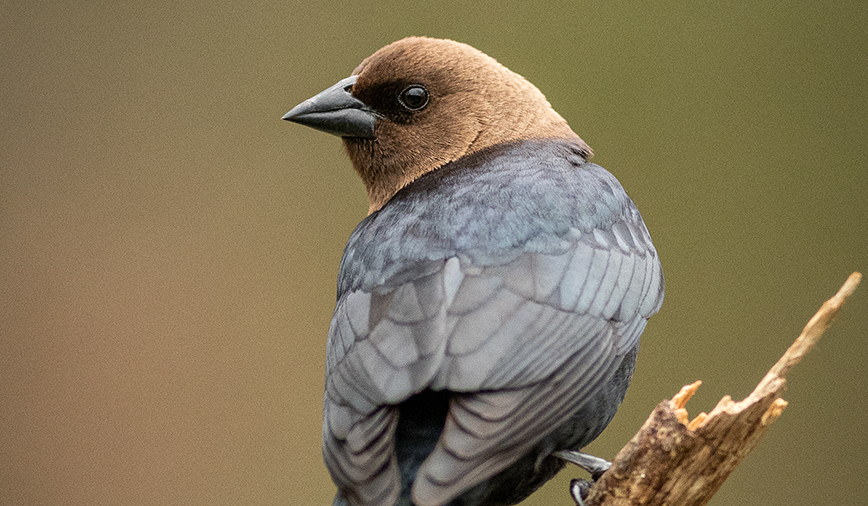Maybe I spent too much time in front of the TV as a kid but, when spring comes, I can’t help but think of Baby Huey. Remember him? Large but lovable, the gi-normous duckling starred in many cartoons during the 1950s and ’60s. Throughout his assorted escapades the sight gag was always the same: giant Baby Huey, stuffed into a too-small baby carriage alongside his doting mom and often-mad dad, both of whom he dwarfed in size.
Very soon, real-life Baby Hueys will begin to pop up in nests around the Tri-Cities—maybe even right outside your window. But unlike the Huey of cartoon legend, these big babies are unrelated to the adult birds raising them. They’re brown-headed cowbirds and, to some conservationists, there’s nothing funny about them.
In the avian world, brown-headed cowbirds are referred to as brood parasites. Simply put, they lay their eggs in other birds’ nests. Zip, plop, and mom cowbird’s reproductive duties are done. The exhaustive tasks of incubating eggs and feeding hatchlings are left to the “adoptive” parents, many of which are considerably smaller than their young charge.
Cowbirds are not only fairly large (they’re in the same family as grackles and orioles), but also have a built-in competitive advantage in the form of a short, 10- to12-day incubation period. While other nestmates are still in their eggs, baby cowbirds have hatched and are begging for food.
Because bird parents of all species are programmed to react to gaping beaks, the earliest-hatching bird most certainly gets the worm (and beetle and spider…) stuffed inside its mouth. Before long, Baby Huey cowbird is the dominant chick in the nest; it may then become the only chick in the nest as the other, smaller chicks are pushed out by their jumbo-sized guest.
Meanwhile, freed of the energy-taxing tasks of building a nest, incubating eggs and feeding young, mom cowbird is busily watching the nest-building behavior of other birds in the area and plotting her next deposit. She may lay as many as 40 eggs over the course of a season—four times as many as even the most prolific songbird species.
Although it may seem that cowbirds are merely out to take advantage of their neighbors’ good nature, their absentee-parent approach actually is an adaptation developed long ago when bison roamed the land. Cowbirds, then referred to as buffalo birds, followed the herds and feasted on the insects and seeds the large beasts churned up.
When a gravid (pregnant-with-eggs) female cowbird found it was time to lay an egg, yet her nest was far away, she found it advantageous to simply put it in another bird’s nest. Over time, this behavior became the norm, and a new brood-parasite species was born.
Egg-dropping is innocent enough and in fact happens fairly often among birds that nest in colonies. But scientists recently have discovered that cowbirds take the behavior to a level that would make even the Corleone family proud…if they were birds. Studying warbler populations in southern Illinois, researchers learned that cowbirds will bully birds that reject their eggs; in what the scientists refer to as “retaliatory mafia behavior,” the parasitic cowbirds often return to the nest where their eggs were ejected, with the sole purpose of destroying the warblers’ own eggs. Further, some cowbirds will “farm” for additional nest sites by first destroying nests that do not contain cowbird eggs, then depositing eggs in the new nests the bullied birds build.
Intimidation techniques aside, cowbirds have another factor working in their favor: us. As we humans have worked to turn open space into suburbia, many of our natural areas have become fragmented. Each “chunk” of woodland, wetland and prairie now is separated from another by streets, houses, and shopping malls; the result is open space with lots of edges—the precise places cowbirds prefer for finding nests to visit.
The result is that, here in Illinois, as well as many other areas around the country, brown-headed cowbird numbers are on the rise. The jury is still out on how this increase will affect birds nesting in our area, but one thing’s for sure. If you have a hankering to see a Baby Huey bird, up close, simply keep an eye on the actions of your nearest Corleone cowbird.
Pam Otto works for the St. Charles Park District and can be reached at potto@stcparks.org or 630-513-4346.

